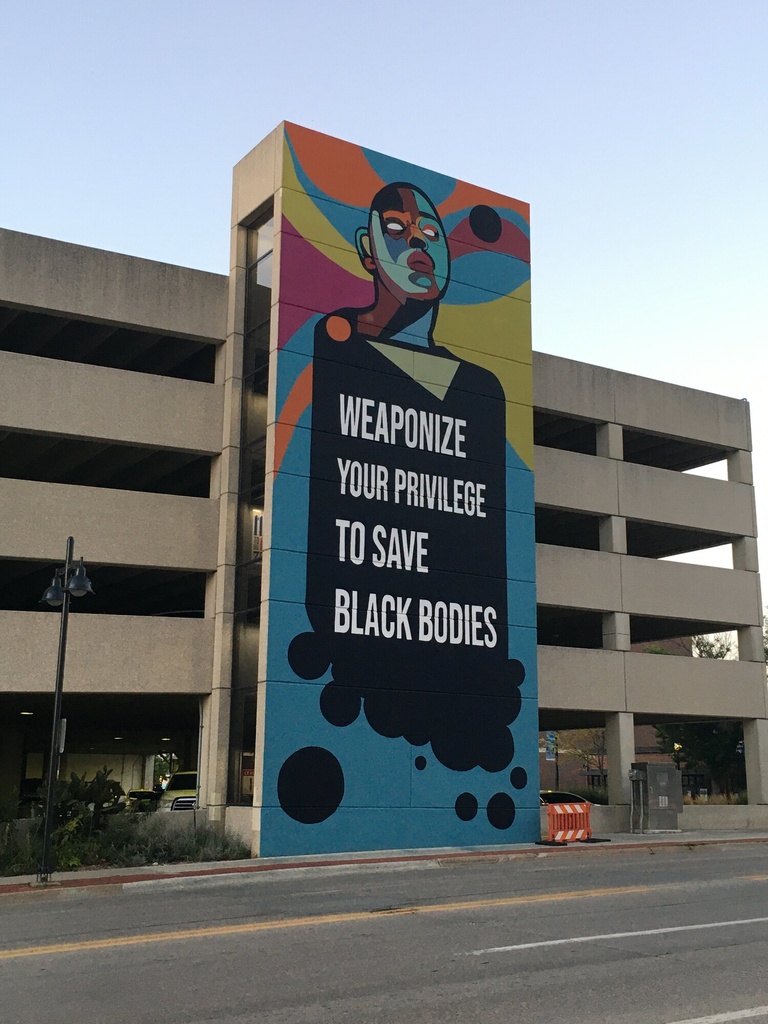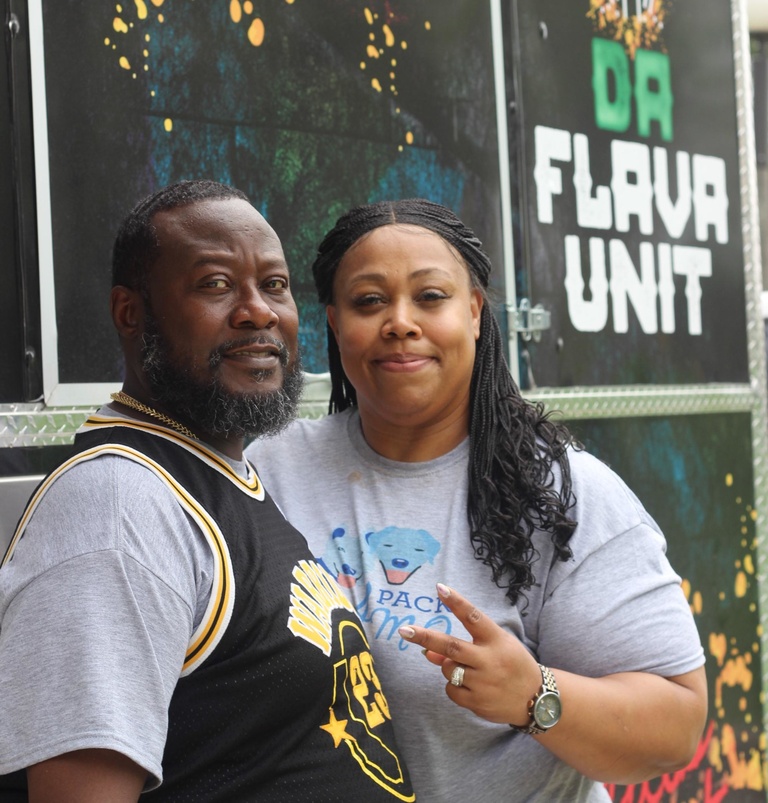Walking through an alley between Linn and North Dubuque Streets, a group of University of Iowa students stop to gaze at a mural that wraps around the backside of a building. Ella Hink, a fourth-year environmental engineering student, comes forward to describe the piece. It quickly becomes obvious that no one can hear her over the noise of an exhaust fan, so they move a few yards up the alley, carefully stepping around puddles and dumpsters.
Hink and her classmates are on a walking tour of public art in downtown Iowa City. Each of them shares the background of a different piece of art--murals, sculptures, sidewalk art, mosaics--including the artist, a background story, and the funding source. In the case of “Raccoon and Fireflies,” designed by artist Dave Lowenstein, Hink admits that she’d hardly noticed the piece despite having walked past it dozens of times. This is amusing because the mural depicts people on cell phones blind to the magic of the natural world, including a raccoon playing with the light emitted by the insects.
Collaborating across disciplines

The tour is part of a class focused on the role of creativity and the arts in placemaking. It is surely one of the most cross-disciplinary classes on campus, in part because it’s actually two courses that choose to meet at the same time and share space and assignments. Travis Kraus teaches Community Development through Creative Placemaking in the School of Planning and Public Affairs, while Loyce Arthur teaches Action! Engage! Art! Creative Placemaking for the Public Good in the Department of Theatre Arts. Students in the class come from those two departments, as well as political science, engineering, dance, and public health. The collaboration is possible through the Iowa Initiative for Sustainable Communities (IISC), a campus-wide community engaged learning program.
The class originated when Arthur, who in addition to being a scholar of costume design is also the coordinator of the new Social Justice and Performing Arts Certificate, reached out to former IISC director Chuck Connerly about a possible collaboration. She became more certain of the value of the cross-disciplinary effort after participating in the Oracles of Iowa City project.
Comprised of two murals that were painted on the south side of the Burlington Street parking garage in summer 2021, the Oracles display the statements: “Black Joy Needs No Permission” and “Weaponize Your Privilege to Save Black Bodies.” The large collaborative team behind the pieces included artists, planners, and scholars.
Everyone involved was clear that it was about more than a mural; rather, the art was entrée into community action. And yet, the murals were going up in a downtown area then void of any Black-owned businesses.
Collecting stories of Black economic development

“This led to talk about the challenges to Black economic development in the City,” says Arthur. “The murals and everything that happened in 2020 pointed toward structural change. We wondered how you take a concept [like the Oracles] and build it into economic development.”
During the first two years Arthur and Kraus taught together, they focused on how to use arts and culture to promote Black advancement and economic inclusion in Iowa City while also considering ways to magnify Black voices. The class project was Grow Black-Owned, a story map highlighting black-owned businesses, non-profits, and entrepreneurs in the greater Iowa City area. Over the course of two separate academic years, students collected stories, including audio and photos, to explore the ways in which arts and culture can serve as a catalyst to advance economic inclusion.
Grant helps class involve participants from westside neighborhood
This year, students in the joined courses will interview residents from the Wonderful Westside Neighborhood. Officially named in January 2023, Iowa City’s newest neighborhood association is anchored by the Pheasant Ridge Apartments off of Mormon Trek Boulevard. Rachel Rockwell, director of the Neighborhood Centers of Johnson County, and Ayman Sharif, director of outreach and engagement for the City of Iowa City and IISC alum, hope the UI students can help capture the rich knowledge and lively energy of the area.
Arthur received a Seeding Excellence grant from The Research Development Office within the Office of the Vice President for Research to provide stipends to neighborhood members who participate in meetings with the class. She and Kraus are eager to make this kind of campus-community partnership as accessible and welcoming as possible.
“We want to get more residents involved in the neighborhood planning process, particularly residents from groups that may be underrepresented in community decision-making,” says Kraus. “Through the grant, we can provide compensation and childcare services that hopefully help overcome some of the barriers to civic engagement.”
Students have been involved in all stages of the project, including the call for participants, thinking through issues of accessibility, graphic design challenges, and conceiving of art projects that celebrate cultural and community pride. For anyone wanting to work in community engagement, these are invaluable skills and ones that make the experience noteworthy for students.
Grounds to wonder
An undergraduate studying political science, Joe Maxwell signed up for the class as part of his minor in urban studies. “I didn’t realize we’d be doing so much in the community,” he says. “A lot of classes about social justice talk about theories and ideas but don’t actually do anything.”
His thoughts are echoed by Holland Larned, an undergraduate theater major who is also getting a social justice certificate. “The class has given me grounds to wonder what a piece of art is doing. When can you call a piece of art activist.”
These questions are alive in the public art walk, which includes a sculpture depicting the Jones Town massacre, a mosaic in the Brain Sciences building that was created via a fund for public art that the Iowa legislature has since dismantled, and neon lighting outside a LGBTQ bar that provides safety to its patrons.
The students themselves are also part of the appeal of the class, though many aren’t aware of this quality when they register. After becoming siloed in specific academic approaches within their home departments, they find it exciting to hear other perspectives and approaches. As Hink, who already has a job secured in Denver, CO, says, “It’s important to know how other people think. I mean, I’m not going to work with people who have the same training and background I do!”
